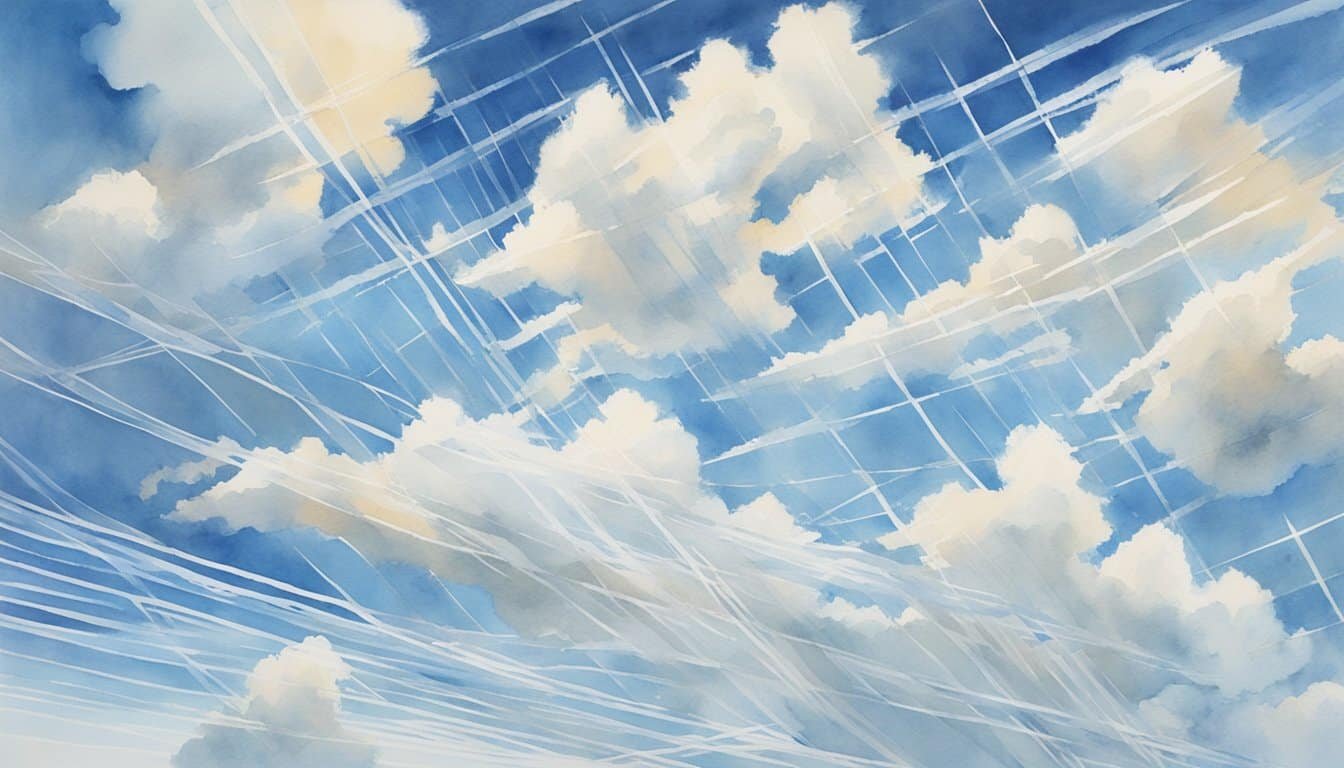Understanding Chemtrails and Contrails
In the realm of skyward phenomena, the discussion often takes a flight towards the curious streaks left by aircraft. These are commonly known as contrails, but some speculate about their more nefarious cousin, ‘chemtrails.’ Let’s clear the air on these topics.
Definitions and Distinctions
Chemtrails are a subject of alternative theories suggesting that some trails left by aircraft deliberately disperse chemical or biological agents for various clandestine purposes. The term is a portmanteau of “chemical” and “trails.” However, these have been debunked by the scientific community as conspiracy theories without credible evidence.
Contrails, on the other hand, are simply condensation trails. When an aircraft soars through the sky, its engines emit hot, humid air in cooler atmospheric regions. This creates visible streaks that consist mostly of water ice crystals. Contrails have been explained through well-established principles of physics and chemistry and are a normal byproduct of aviation.
Scientific Explanations of Condensation Trails
Condensation trails, or contrails, form due to the condensation of water vapor contained in the aircraft’s exhaust. This process is influenced by multiple factors including temperature, humidity, and the aircraft’s altitude. When a plane flies high enough where the air is colder than -40 degrees Celsius, the water vapor from the engines freezes quickly, forming ice crystals.
Atmospheric scientists confirm that contrails can evolve into cloud-like formations, sometimes persisting or spreading to form a thin veil of cirrus clouds. This natural phenomenon has been a topic of environmental research letters, delving into how these artificial clouds might affect the environment, which is still an ongoing area of investigation.
The Chemtrail Conspiracy Theory

Chemtrails are a subject of widespread debate and speculation, with a significant faction convinced these streaks in the sky are part of a covert operation. This section delves into the foundation of such beliefs and the contrasting views from the scientific community.
Origins and Claims of Conspiracy Theorists
The chemtrail conspiracy theory suggests that the trails left by planes in the sky are not mere water vapor contrails, but rather chemtrails—chemical or biological agents deliberately sprayed for nefarious purposes. Proponents argue that some contrails have an unusual appearance and persistence in the sky, fueling suspicion. They posit that the government or other powerful entities could be using these chemicals for weather modification, population control, or even psychological manipulation. Social media platforms like Facebook have been breeding grounds for such theories, spreading information that often lacks scientific verification.
Claims of chemtrails encompass a variety of substances being dispersed into the air, including barium, aluminum, and other toxic compounds. Figures like Alex Jones have been instrumental in amplifying these narratives, attracting attention to the issue and accusing the government and private institutions of collaboration in these supposed activities. Yet, despite the intense online presence, these chemtrail accusations lack corroborating physical evidence and often clash with established scientific knowledge.
Contrasting Evidence and Peer-Reviewed Studies
In contrast to chemtrail claims, peer-reviewed studies from reputable institutions like the Carnegie Institution for Science and NASA have dissected these theories. Research shows that persistent contrails are a normal and expected result of water vapor condensing at high altitudes, forming ice crystals that can linger in the sky.
Far from the conjecture of conspiracy theories, these peer-reviewed studies present evidence against the intentional dispersal of harmful chemicals. A paper discusses the interpretation of contrails as chemtrails and the ramifications of such beliefs for international politics and policy regarding geoengineering. Efforts have also been made by experts to debunk chemtrail myths, explaining atmospheric science to the public.
Google and other platforms have taken steps to reduce the spread of misinformation, countering fake news and baseless claims with credible information. Despite the allure and persistence of the chemtrail conspiracy within certain circles, it remains primarily a sociological phenomenon rather than a subject substantiated by empirical evidence.
Environmental and Health Implications

The topic of chemtrails sparks a mix of curiosity and concern, particularly around their effect on the environment and human health. These supposed streaks across the sky raise questions about their role in climate change and their potential risks to public well-being.
Impact of Contrails on Climate and Weather
Contrails, short for condensation trails, are clouds formed when water vapor from aircraft exhaust condenses and freezes in the upper atmosphere. The impact of contrails on climate and weather is an active area of environmental research. Studies show that contrails can contribute to global warming by trapping heat within the atmosphere, similar to how clouds prevent a chilly night after a sunny day. This effect can potentially alter climate patterns, yet it’s different from the conspiracy theories alleging weather modification or mind control.
Contrails sometimes persist and spread into cirrus-like clouds that can influence both sunlight reaching the Earth and heat escaping it, influencing weather on a local scale. Atmospheric science, including work by agencies such as the National Oceanic and Atmospheric Administration, continues to assess these impacts.
Public Health Concerns and Potential Risks
Public health is another hot topic when it comes to discussions around chemtrails. The concern is whether these trails contain harmful chemicals like barium, aluminum, or strontium, which are sometimes mentioned in conspiracy theories but lack scientific substantiation when it comes to chemtrails. Chemtrails are often confused with credible techniques such as solar geoengineering, which explores the possibility of reflecting sunlight to reduce global warming.
There’s also a broader concern regarding air travel and the release of pollutants into the atmosphere, including carbon dioxide and nitrous oxides, which have well-established health and environmental impacts. While there’s no concrete evidence linking chemtrails to schemes of defense, biological weapons testing, or sterilization, the topic stimulates an important conversation on the potential perils of unchecked atmospheric experimentation.

